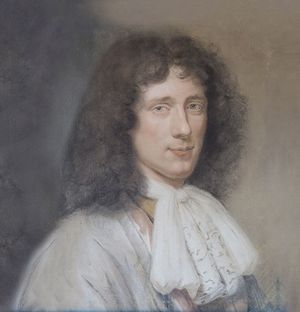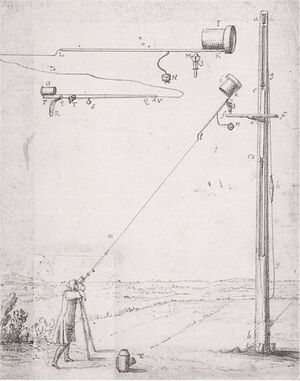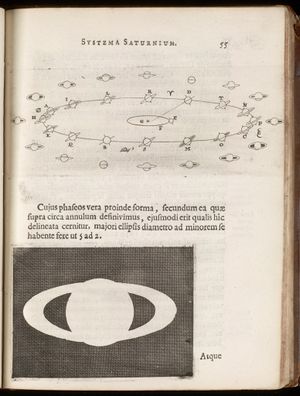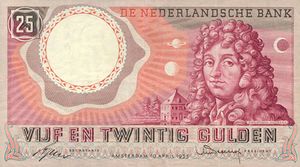كريستيان هويگنز
كريستيان هويگنز Christiaan Huygens | |
|---|---|
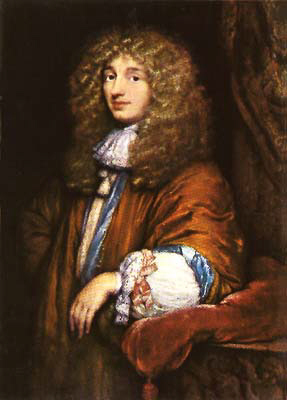 كريستيان هويگنز | |
| وُلِدَ | 14 April 1629 |
| توفي | 8 July 1695 (aged 66) |
| القومية | هولندي |
| المدرسة الأم | جامعة لايدن كلية اورانج |
| عـُرِف بـ | تيتان Explanation حلقات زحل قوة طاردة مركزية Collision formulae Pendulum clock مبدأ هويگنز-فرينل نظرية الموجات Birefringence First theoretical physicist |
| السيرة العلمية | |
| المجالات | فيزياء Mathematics علم الفلك Horology خيال علمي |
| الهيئات | [[الجمعية الملكية بلندن
]] أكاديمية العلوم الفرنسية |
| المشرف على الدكتوراه | فرانس ڤان سخوتن جون پل |
| أثـَّر عليه | رينيه ديكارت فرانس ڤان شوتن بليز پاسكال ماران مرسن |
| أثـّر على | گوتفريد ڤيلهلم لايبنتس إسحاق نيوتن |
| ميكانيكا كلاسيكية | ||||||||
تاريخ...
| ||||||||
كريستيان هويگنز Christiaan Huygens ؛ FRS (/ˈhaɪɡənz/ HY-gənz,[1] also US: /ˈhɔɪɡənz/ HOY-gənz,[2][3] هولندية: [ˈkrɪstijaːn ˈɦœyɣə(n)s] (![]() استمع); لاتينية: Hugenius؛ و.1629 – 1695). عالم فيزياء وفلك ورياضيات ومخترع هولندي، , who is widely regarded as one of the greatest scientists of all time and a major figure in the scientific revolution. In physics, Huygens made groundbreaking contributions in optics and mechanics, while as an astronomer he is chiefly known for his studies of the rings of Saturn and the discovery of its moon Titan. As an inventor, he improved the design of the telescope with the invention of the Huygenian eyepiece. His most famous invention, however, was the pendulum clock in 1656, which was a breakthrough in timekeeping and became the most accurate timekeeper for almost 300 years. Huygens was an outstanding mathematician and, because he was arguably the first scientist of the modern era to transfer mathematical inquiry to explain unobservable physical phenomena, he has been called the first theoretical physicist and one of the founders of modern mathematical physics.[4][5][6]
استمع); لاتينية: Hugenius؛ و.1629 – 1695). عالم فيزياء وفلك ورياضيات ومخترع هولندي، , who is widely regarded as one of the greatest scientists of all time and a major figure in the scientific revolution. In physics, Huygens made groundbreaking contributions in optics and mechanics, while as an astronomer he is chiefly known for his studies of the rings of Saturn and the discovery of its moon Titan. As an inventor, he improved the design of the telescope with the invention of the Huygenian eyepiece. His most famous invention, however, was the pendulum clock in 1656, which was a breakthrough in timekeeping and became the most accurate timekeeper for almost 300 years. Huygens was an outstanding mathematician and, because he was arguably the first scientist of the modern era to transfer mathematical inquiry to explain unobservable physical phenomena, he has been called the first theoretical physicist and one of the founders of modern mathematical physics.[4][5][6]
In 1659, Huygens was the first to derive geometrically the now standard formulae for the centripetal force and centrifugal force in his work De vi centrifuga. [7] The formulae played a central role in classical mechanics. Huygens was also the first to identify the correct laws of elastic collision in his work De motu corporum ex percussione, but his findings were not published until 1703, after his death. In the field of optics, he is best known for his wave theory of light, which he proposed in 1678 and described in 1690 in his Treatise on Light, which is regarded as the first mathematical theory of light. His theory was initially rejected in favor of Isaac Newton's corpuscular theory of light, until Augustin-Jean Fresnel adopted Huygens' principle in 1818 and showed that it could explain the rectilinear propagation and diffraction effects of light. Today this principle is known as the Huygens–Fresnel principle.
Huygens invented the pendulum clock in 1656, which he patented the following year. In addition to this invention, his research in horology resulted in an extensive analysis of the pendulum in his 1673 book Horologium Oscillatorium, which is regarded as one of the most important seventeenth-century works in mechanics. While the first part of the book contains descriptions of clock designs, most of the book is an analysis of pendulum motion and a theory of curves. In 1655, Huygens began grinding lenses with his brother Constantijn in order to build telescopes to conduct astronomical research. He designed a 50-power refracting telescope with which he discovered that the ring of Saturn was "a thin, flat ring, nowhere touching, and inclined to the ecliptic." It was with this telescope that he also discovered the first of Saturn's moons, Titan. He eventually developed in 1662 what is now called the Huygenian eyepiece, a telescope with two lenses, which diminished the amount of dispersion.
As a mathematician, Huygens developed the theory of evolutes and was a pioneer on probability, writing his first treatise on probability theory in 1657 entitled Van Rekeningh in Spelen van Gluck. Frans van Schooten, who was the private tutor of Huygens, translated the work as De ratiociniis in ludo aleae ("On Reasoning in Games of Chance"). The work is a systematic treatise on probability and deals with games of chance and in particular the problem of points. The modern concept of probability grew out of the use of expectation values by Huygens and Blaise Pascal (who encouraged him to write the work).
أوضح عام 1678م أن الضوء يتكون من سلسلة من الموجات. وقد استخدم نظريته هذه في دراسة انكسار الضوء. وقد زاحمت نظرية الموجات هذه لسنين طويلة نظرية الجسيمات للعالم الإنجليزي إسحق نيوتن، الذي كان يصر على أن الضوء مكون من جسيمات أو ذرات. ويعتقد العلماء في الوقت الحاضر أن الضوء يسلك المسلكين معًا، وهما الجسيمات والموجات.
النشأة
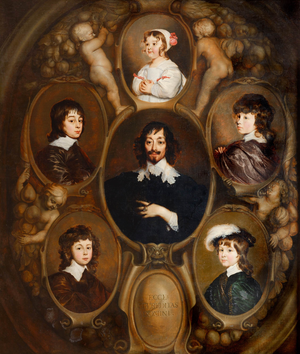
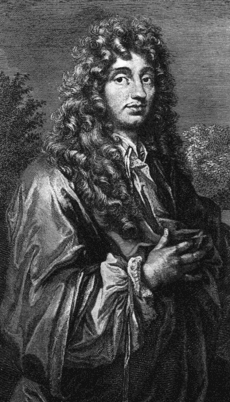
Christiaan Huygens was born on 14 April 1629 in The Hague, into a rich and influential Dutch family,[8][9] the second son of Constantijn Huygens. Christiaan was named after his paternal grandfather.[10][11] His mother was Suzanna van Baerle. She died in 1637, shortly after the birth of Huygens' sister.[12] The couple had five children: Constantijn (1628), Christiaan (1629), Lodewijk (1631), Philips (1632) and Suzanna (1637).[13]
Constantijn Huygens was a diplomat and advisor to the House of Orange, and also a poet and musician. His friends included Galileo Galilei, Marin Mersenne, and René Descartes.[14] Huygens was educated at home until turning sixteen years old. He liked to play with miniatures of mills and other machines. His father gave him a liberal education: he studied languages and music, history and geography, mathematics, logic and rhetoric, but also dancing, fencing and horse riding.[10][13][15]
In 1644 Huygens had as his mathematical tutor Jan Jansz de Jonge Stampioen, who assigned the 15-year-old a demanding reading list on contemporary science.[16] Descartes was impressed by his skills in geometry, as did Mersenne, who christened him "the new Archimedes."[4][9][17]
ولد في مدينة لاهاي Hague، نشأ في وسط عائلي متميز ثري ومثقف. فوالده دبلوماسي يقرض الشعر، ويهتم بالرياضيات، وكانت له صلات مع الفيلسوف ديكارت وغيره من الطبقة المثقفة الراقية.
سنوات الدراسة
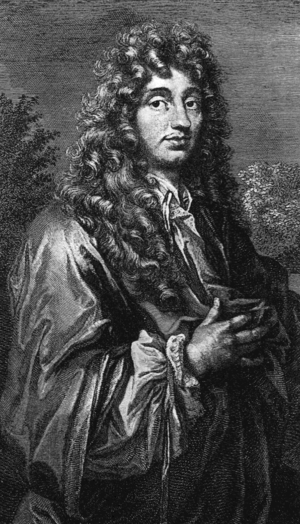
درس الرياضيات والقانون في جامعة لايدن وفي كلية أورانج في بريد. كما اكتشف هايجنز أيضًا توابع لكوكب زحل، وأكد أن ما يسميه علماء الفلك بأذرع زحل ما هو إلا حلقة حول الكوكب المذكور.
كان باكورة أعماله مذكرة في الهندسة نشرت سنة 1651، ولفتت انتباه ديكارت. واتجه بعدئذ إلى الفيزياء، ودرس البصريات وفي عام 1655 سافر إلى فرنسا حيث نال دكتوراه في الحقوق. ولدى عودته إلى هولندا صنع بمساعدة أخيه الأكبر عدسات للنظارات، وبدأ أولى أرصاده الفلكية.[18]
في عام 1666 استقر في باريس، ومنح عضوية أكاديمية العلوم الفرنسية، وخصص له الملك لويس الرابع عشر - بناء على نصيحة من مستشاره كولبير Colbert (مؤسس الأكاديمية الفعلي وباني اقتصاد فرنسا) - نفقة قيمة. وهكذا تفرغ للبحث العلمي، وفُتحت أمامه أبواب الطبقة المميزة من مثقفي فرنسا ورجالاتها.
الفيزياء
كان أهم حدث في أثناء إقامته في باريس كتاباً نشره عام 1673 حول الاهتزاز والميقاتية تحت عنوان Horologium Oscillatorium. ففي هذا الكتاب أسّس هويگنز نظرية ناشر منحن ومنشوره؛ أي المحل الهندسي لمراكز تقوسه (فقد أظهرت هذه الدراسة فكرة انحناء منحن أو تقوسه ونصف قطر انحنائه، ومهدت للهندسة التفاضلية). ويعدّ هويگنز مؤسس نظرية الاهتزازات في الفيزياء، فقد درس فكرة النواس البسيط، ووضع معادلة حركته، وبيَّن أن زمن دورته شبه ثابت.
لم يكن هويگنز رياضياً بمستوى نيوتن، ولكنه كان من الرواد الأوائل في الرياضيات والفيزياء. واشتهر في البصريات بفرضيته عن حقيقة سير الضوء؛ فقد قال: إن الضوء ينتقل على شكل موجات يرسلها الجسم المضيء. وهذا بخلاف ما قال به نيوتن من أن الضوء هو جسيمات يصدرها المضيء. وهكذا استطاع هويگنز أن يفسر بفرضيته هذه الظواهر والخواص الضوئية المعروفة في ذلك الحين جميعها والتي لم تستطع فرضية نيوتن تفسيرها. ويُذكر منها تفسيره ظاهرةَ الانكسار، وتقتضي فرضيته أن يكون سير الضوء في وسط كثيف أبطأ من سيره في وسط مخلخل، وهذا يتعارض مع فرضية نيوتن التي تقتضي أن يكون الضوء أسرع في الوسط الكثيف. وقد ثبتت فرضية هويگنز مع الفارق أن موجات الضوء عرضانية وليست طولانية كما قال هويگنز.
الميكانيكا
كان فيزيائياً متميزاً تجلت عبقريته في البصريات وفي الميكانيك؛ إذ شارك لايبنتز في نظرية القوى الحية (التي تحولت إلى فكرة الطاقة الحركية)، ويعزى إليه مفهوم القوة النابذة وكذلك مفهوم عزم العطالة واكتشاف ظاهرة التجاوب.
الفلك
ولم تمض سوى ست سنوات بعد ذلك حتى قُبل عضواً في الجمعية الملكية في لندن، فقد استطاع قبلها أن يتعرف بمقرابه شكل حلقات زحل، واكتشف أيضاً سادس أقماره (تيتان)، إضافة إلى دوران المريخ والبقع القاتمة على المشتري، واستعمل أداة (ميكرومتر) لقياس قطر نجم. وهو أول من بيَّن أن النجوم هي شموس قد يكون لها كواكب فيها أحياء.
البصريات
وقد تعاون في العمل مع أخيه قُسطنطين لتطوير المهارة في تجليخ وصقل العدسات البصرية الكروية الشكل. وقد استخدم هذان الشقيقان هذه العدسات لصنع أقوى تلسكوب في عصرهما.
الساعات
وفي عالم الرياضيات أدخل هايجنز تعديلاً على قيمة باي التي تدل على النسبة التقريبية بين محيط الدائرة وقطرها. وفي الخمسينيات من القرن السابع عشر.
في عام 1657 ابتكر الميقاتية ذات الرقاص، واعتمد على فكرة رد الفعل المعاكس بابتكاره أداة (لها شكل المرساة) تحافظ على حـركتها. فكانت هذه الميقاتية - مع كرّاس كان قـد نشره قبل عام حـول قضية مستجدة أثارت جـدلاً في الاحتمالات - هي سبب شهرته الشعبية (لأن أوربا كانت آنذاك بحاجة لساعة تسهل على الملاحين تعيين خط طول المكان الذي وصلوا إليه في حركة أساطيلهم الاستعمارية عبر البحار، فاقترح هويگنز أيضاً استخدام ساعة تعمل وفق اهتزازات نابض حلزوني).
وفاته
أقام هويگنز في فرنسا حتى عام 1681. ولكن المضايقات التي راح يتعرض لها معتنقو المذهب البروتستنتي في فرنسا (وهويگنز منهم) أرغمته أخيراً على العودة إلى هولندا. ولم ينشر كتابه «في الضوء» وكذلك كتابه «في الثقالة» إلا عام 1690. وتميزت السنوات الخمس الأخيرة من حياته باعتلال صحته وبشعور متزايد بالوحدة والكآبة، وتوفي في مدينة لاهاي.
أعماله
- 1649 - De iis quae liquido supernatant (About the parts above the warer, unpublished)
- 1651 - Cyclometriae
- 1651 - Theoremata de quadratura hyperboles, ellipsis et circuli (theorems concerning the quadrature of the hyperbola, ellipse and circle, Huygens' first publication)
- 1654 - De circuli magnitudine inventa
- 1656 - De Saturni Luna observatio nova (About the new observation of the moon of Saturn - discovery of Titan)
- 1656 - De motu corporum ex percussione, published only in 1703
- 1657 - De ratiociniis in ludo aleae = Van reeckening in spelen van geluck (translated by Frans van Schooten)
- 1659 - Systema saturnium
- 1673 - Horologium oscillatorium sive de motu pendularium (theory and design of the pendulum clock, dedicated to Louis XIV of France)
- 1673 - De vi centrifuga (Concerning the centrifugal force)
- 1684 - Astroscopia Compendiaria tubi optici molimine liberata (compound telescopes without a tube)
- 1685 - Memoriën aengaende het slijpen van glasen tot verrekijckers (How to grind telescope lenses)
- 1686 - Kort onderwijs aengaende het gebruijck der horologiën tot het vinden der lenghten van Oost en West (How to use clocks to establish the longitude
- 1690 - Traité de la lumière
- 1690 - Discours de la cause de la pesanteur (Discourse about gravity, from 1669?)
- 1691 - Lettre touchant le cycle harmonique (Rotterdam, concerning the 31-tone system)
- 1698 - Cosmotheoros , sciencefiction
- 1703 - Opuscula posthuma including
- De motu corporum ex percussione (Concerning the motions of colliding bodies - contains the first correct laws for collision, dating from 1656).
- Descriptio automati planetarii (description and design of a planetarium)
- 1724 - Novus cyclus harmonicus (Leiden, after Huygens' death)
- 1728 - Christiani Hugenii Zuilichemii, dum viveret Zelhemii toparchae, opuscula posthuma ... (pub. 1728) Alternate title: Opera reliqua, concerning optics and physics
- 1888-1950 - Huygens, Christiaan. Oeuvres complètes. The Hague Complete work, editors D. Bierens de Haan (tome=deel 1-5), J. Bosscha (6-10), D.J. Korteweg (11-15), A.A. Nijland (15), J.A. Vollgraf (16-22).
- Tome I: Correspondance 1638-1656 (1888). Tome II: Correspondance 1657-1659 (1889). Tome III: Correspondance 1660-1661 (1890). Tome IV: Correspondance 1662-1663 (1891). Tome V: Correspondance 1664-1665 (1893). Tome VI: Correspondance 1666-1669 (1895). Tome VII: Correspondance 1670-1675 (1897). Tome VIII: Correspondance 1676-1684 (1899). Tome IX: Correspondance 1685-1690 (1901). Tome X: Correspondance 1691-1695 (1905).
- Tome XI: Travaux mathématiques 1645-1651 (1908). Tome XII: Travaux mathématiques pures 1652-1656 (1910).
- Tome XIII, Fasc. I: Dioptrique 1653, 1666 (1916). Tome XIII, Fasc. II: Dioptrique 1685-1692 (1916).
- Tome XIV: Calcul des probabilités. Travaux de mathématiques pures 1655-1666 (1920).
- Tome XV: Observations astronomiques. Système de Saturne. Travaux astronomiques 1658-1666 (1925).
- Tome XVI: Mécanique jusqu’à 1666. Percussion. Question de l’existence et de la perceptibilité du mouvement absolu. Force centrifuge (1929). Tome XVII: L’horloge à pendule de 1651 à 1666. Travaux divers de physique, de mécanique et de technique de 1650 à 1666. Traité des couronnes et des parhélies (1662 ou 1663) (1932). Tome XVIII: L'horloge à pendule ou à balancier de 1666 à 1695. Anecdota (1934). Tome XIX: Mécanique théorique et physique de 1666 à 1695. Huygens à l’Académie royale des sciences (1937).
- Tome XX: Musique et mathématique. Musique. Mathématiques de 1666 à 1695 (1940).
- Tome XXI: Cosmologie (1944).
- Tome XXII: Supplément à la correspondance. Varia. Biographie de Chr. Huygens. Catalogue de la vente des livres de Chr. Huygens (1950).
پورتريهات
في حياته
- 1639 - His father Constantijn Huygens in the midst of his five children by Adriaen Hanneman, painting with medaillons, Mauritshuis, The Hague
- 1671 - Portrait by Caspar Netscher, Museum Boerhaave, Leiden, loan from Haags Historisch Museum
- ~1675 - Possible depiction of Huygens on l'Établissement de l'Académie des Sciences et fondation de l'observatoire, 1666 by Henri Testelin. Colbert presents the members of the newly founded Académie des Sciences to king Louis XIV of France. Musée National du Château et des Trianons de Versailles, Versailles
- 1679 - Medaillon portrait in relief by the French sculptor Jean-Jacques Clérion
- 1686 - Portrait in pastel by Bernard Vaillant, Museum Hofwijck, Voorburg
- bewteen 1684 and 1687 - Engraving by G. Edelinck after the painting by Netscher
- 1688 - Portrait by Pierre Bourguignon, Koninklijke Nederlandse Akademie van Wetenschappen, Amsterdam
سميت على إسمه
العلوم
- The Huygens probe: The lander for the Saturnian moon Titan, part of the Cassini-Huygens Mission to Saturn
- Asteroid 2801 Huygens
- A crater on Mars
- Mons Huygens, a mountain on the Moon
- Huygens Software, a microscope image processing package.
- Achromatic two element eyepiece designed by him.
- The Huygens–Fresnel principle, a simple model to understand disturbances in wave propagation.
- Huygens wavelets, the fundamental mathematical basis for scalar diffraction theory
- W.I.S.V. Christiaan Huygens: Dutch study guild for the studies Mathematics and Computer Science at the Delft University of Technology
- Huygens Laboratory: Home of the Physics department at Leiden University, The Netherlands
- Huygens Supercomputer: National Supercomputer facility of The Netherlands, located at SARA in Amsterdam
- The Huygens-building in Noordwijk, The Netherlands, first building on the Space Business park opposite Estec (ESA)
- The Huygens-building at the Radboud University, Nijmegen, The Netherlands. One of the major buildings of the science department at the university of Nijmegen.
أخرى
- Christiaan Huygens College, High School located in Eindhoven, The Netherlands.
- The Christiaan Huygens, a ship of the Nederland Line.
انظر أيضا
المصادر
- ^ قالب:Cite Oxford Dictionaries
- ^ قالب:Cite Merriam-Webster
- ^ "Huygens". Random House Webster's Unabridged Dictionary.
- ^ أ ب Dijksterhuis, F. J. (2005). Lenses and Waves: Christiaan Huygens and the Mathematical Science of Optics in the Seventeenth Century. Kluwer Academic Publishers. pp. 1–2.
- ^ Dijksterhuis, F.J. (2008) Stevin, Huygens and the Dutch republic. Nieuw archief voor wiskunde, 5, pp. 100-107.https://research.utwente.nl/files/6673130/Dijksterhuis_naw5-2008-09-2-100.pdf
- ^ Andriesse, C.D. (2005) Huygens: The Man Behind the Principle. Cambridge University Press. Cambridge: 6
- ^ Andriesse, C.D. (2005) Huygens: The Man Behind the Principle. Cambridge University Press. Cambridge: 354
- ^ Stephen J. Edberg (14 December 2012) Christiaan Huygens, Encyclopedia of World Biography. 2004. Encyclopedia.com.
- ^ أ ب http://www.saburchill.com/HOS/astronomy/016.html
- ^ أ ب Henk J. M. Bos (14 December 2012) Huygens, Christiaan (Also Huyghens, Christian), Complete Dictionary of Scientific Biography. 2008. Encyclopedia.com.
- ^ R. Dugas and P. Costabel, "Chapter Two, The Birth of a new Science" in The Beginnings of Modern Science, edited by Rene Taton, 1958,1964, Basic Books, Inc.
- ^ Strategic Affection? Gift Exchange in Seventeenth-Century Holland, by Irma Thoen, pg 127
- ^ أ ب Constantijn Huygens, Lord of Zuilichem (1596–1687), by Adelheid Rech
- ^ The Heirs of Archimedes: Science and the Art of War Through the Age of Enlightenment, by Brett D. Steele, pg. 20
- ^ entoen.nu: Christiaan Huygens 1629–1695 Science in the Golden Age
- ^ Jozef T. Devreese (31 October 2008). 'Magic Is No Magic': The Wonderful World of Simon Stevin. WIT Press. pp. 275–6. ISBN 978-1-84564-391-1. Retrieved 24 April 2013.
- ^ Yoeder, J. G. (1988). Unrolling Time. Cambridge University Press. pp. 169–179.
- ^ وائل الأتاسي. "هويگنز (كريستيان ـ)". الموسوعة العربية. Retrieved 2012-10-01.
قراءات إضافية
- Andriesse, C.D., 2005, Huygens The Man Behind the Principle. Foreword by Sally Miedema. Cambridge University Press.
- Boyer, C.B.: A history of mathematics, New York, 1968
- Dijksterhuis, E. J.: The Mechanization of the World Picture: Pythagoras to Newton
- Hooijmaijers, H.: Telling time - Devices for time measurement in Museum Boerhaave - A Descriptive Catalogue, Leiden, Museum Boerhaave, 2005
- Struik, D.J.: A history of mathematics
- Van den Ende, H. et al: Huygens's Legacy, The golden age of the pendulum clock, Fromanteel Ltd, Castle Town, Isle of Man, 2004
- Yoder, J G., 2005, "Book on the pendulum clock" in Ivor Grattan-Guinness, ed., Landmark Writings in Western Mathematics. Elsevier: 33-45.
- Christiaan Huygens (1629-1695) : Library of Congress Citations. Retrieved 2005-03-30.
وصلات خارجية
مصادر أولية وترجمات
- أعمال من Christiaan Huygens في مشروع گوتنبرگ
- Treatise on Light translated into English by Silvanus P. Thompson, Project Gutenberg etext.
- De Ratiociniis in Ludo Aleae or The Value of all Chances in Games of Fortune, 1657Christiaan Huygens' book on probability theory. An English translation published in 1714. Text pdf file.
- Horologium oscillatorium (German translation, pub. 1913) on the pendulum clock
- ΚΟΣΜΟΘΕΩΡΟΣ (Cosmotheoros). (English translation of Latin, pub. 1698; subtitled The celestial worlds discover'd: or, Conjectures concerning the inhabitants, plants and productions of the worlds in the planets.)
- Traité de la lumière or Treatise on light (English translation, pub. 1912 and again in 1962)
- Systema Saturnium 1659 text a digital edition of Smithsonian Libraries
- On Centrifugal Force (1703)
- Huygens' work at WorldCat
متاحف
- Huygensmuseum Hofwijck in Voorburg, The Netherlands, where Huygens lived and worked.
- Huygens Clocks exhibition from the Science Museum, London
- Exhibition on Huygens in University Library Leiden (in Dutch)
أخرى
- O'Connor, John J.; Robertson, Edmund F., "كريستيان هويگنز", MacTutor History of Mathematics archive
- Huygens and music theory Huygens-Fokker Foundation —on Huygens' 31 equal temperament and how it has been used
- Christiaan Huygens on the 25 Dutch Guilder banknote of the 1950s.
- Pages using infobox scientist with unknown parameters
- Articles containing لاتينية-language text
- Pages using Lang-xx templates
- مواليد 1629
- وفيات 1695
- فلكيو القرن 17
- كتاب لاتينية من القرن 17
- رياضياتيو القرن 17
- مكتشفو القمر
- فلكيون هولنديون
- مخترعون هولنديون
- رياضياتيون هولنديون
- منظرو موسيقى هولنديون
- فيزيائيون هولنديون
- زملاء الجمعية الملكية
- خريجو جامعة لايدن
- أشخاص من لاهاي
- صناع أجهزة علمية
- فيزيائيون نظريون
- أشخاص من العصر الذهبي الهولندي

